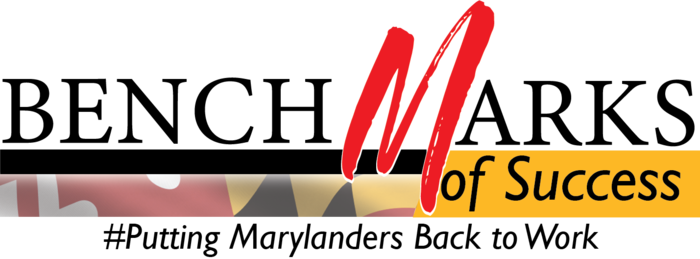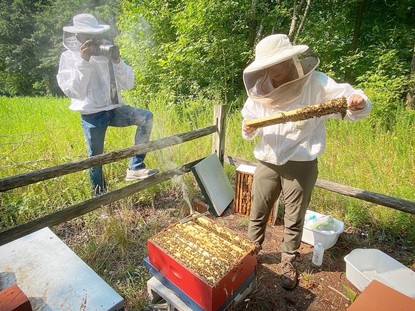
|
|
Monthly Newsletter - Issue 27, Summer 2021
|
 Baltimore County Offers Youth Valuable Employment Experiences
This was a big year for Baltimore County’s Youth Services Program. Baltimore County’s Department of Economic and Workforce Development and the Baltimore Community Foundation announced in early June that the County’s Summer Youth Employment Program received four grants totaling $307,000; $100,000 from the Harry and Jeanette Weinberg Foundation, $100,000 from BGE, $60,000 from Bank of America, and $47,000 from Cities for Financial Empowerment Fund (CFE Fund) and the Citi Foundation’s Summer Jobs Connect Initiative. The County is using the funds to support a diverse range of youth employment initiatives that include providing financial literacy education and expanding banking options, offering services to more youth in Asset Limited, Income Constrained, and Employed (ALICE) communities, and hiring additional support staff.
Baltimore County’s 2021 Summer Youth Employment Program provides a six-week summer employment program for youth, ages 14-21, offering real-world work experiences that are either onsite or virtual. Youth who participate in onsite opportunities work up to 25 hours per week, earning $11.75 per hour with one of more than 60 participating employers, or are placed in one of Baltimore County’s Government departments. Youth who participate in a virtual work experience utilize an online platform called Baltimore County Youth Career EDGE to engage in customized essential jobs skills and workforce development training. Prior to the start of work, all youth participated in structured job readiness and conflict resolution training hosted by the Community College of Baltimore County and the Conflict Resolution Center of Baltimore County. The 2021 Summer Youth Employment Program began on July 6th and will end on August 13th.
Prior to the 2021 Summer Youth Employment Program, 93 youth assisted with the County’s COVID-19 response to prepare and distribute food. Youth were able to earn a wage for 3 hours each Saturday throughout the pandemic. Baltimore County has since distributed over 16 million meals to families in need. Although food distribution concluded on June 26th, the County plans to continue to address food insecurities.
Baltimore County through partnership with the Community College of Baltimore County also offers services to out-of-school youth between 18-24. The L.E.A.P. (Learn Earn Achieve and Progress) Program provides young adults with the opportunity to receive holistic training and support services that increase knowledge, workforce preparation, academic skills, competencies, and credentials leading to entry-level employment and long-term success in a career pathway. These comprehensive education and employment services will help to prepare young adults for success in the workplace and in life. The program offers an opportunity to gain an industry-recognized certification and acquire employment and work-based learning experiences.
More information about Baltimore County’s Youth Services is available at: https://www.baltimorecountymd.gov/departments/economicdev/job-seekers/youth-services/.
Subscribe to Baltimore County’s monthly Youth Connections Newsletter
_______________________________

COVID-19 Corner
VaxU Incentive Program Awards $50,000 Scholarships to Promote COVID Vaccines for Young People
The Food and Drug Administration authorized use of the Pfizer-BioNTech vaccine for adolescents 12 to 15 years of age in early May of this year. All Marylanders 12 and older are eligible for vaccination. Although younger people are less likely to contract severe COVID, it is still imperative for teens to get vaccinated to be protected from the virus and to help stop the virus’s spread.
Maryland’s newest COVID vaccine promotion, announced by Governor Larry Hogan on July 7, 2021, is the $1 million VaxU incentive scholarship program. Twenty Maryland youth between the ages of 12 and 17 years old will be selected to receive $50,000 scholarships in a series of twice-per-week random drawings beginning the week of July 12 – 16 and continuing through Labor Day.
Read more about the VaxU program here.
Visit the Maryland Department of Health’s COVID resource website to learn more about COVID vaccines and to locate a vaccination site near you.
|
|
|
|
|
LEAP Helps Taylor Launch Her Healthcare Career

Just before the COVID-19 pandemic hit, Taylor enrolled in the LEAP program to realize her long-held goal of building a career in the healthcare industry. LEAP provided Taylor with Medical Front Office training as a career entry point. Prior to entering the LEAP program, her only work experience was as a hair stylist which did not provide her with a consistent income to live on. She quickly adjusted to the shift to online classes and virtual learning, successfully progressing through all of her support classes and learning about topics related to life management, job readiness, financial literacy, and computer skills. By the end of the summer, she also passed all of her Medical Front Office classes with flying colors.
In the fall of 2020, she participated in a temporary Work Experience Learning Opportunity placement as a Customer Service Associate with Walgreens so she could add hands-on experience to her resume. With the help of her LEAP Job Developer, Taylor was able to transition into full-time, permanent employment. She began her career in healthcare as a Medical Practice Representative working for University of Maryland Eye Associates on January 19, 2021. She is now working full time and receiving benefits.
Baltimore County’s LEAP staff are very proud of Taylor’s success. She has been motivated and responsive to the LEAP team’s support, and she worked closely with her Job Developer to secure this position through the University of Maryland Medical Center initiative.
|
Workforce Partners
Maryland Department of Labor Maryland Department of Human Services
Maryland State Department of Education Governor's Workforce Development Board
Maryland Department of Housing and Community Development Maryland Workforce Association
|
|
Did You Know...?
|
Maryland's Latest Workforce Development Updates
-
Department of Human Services’ (DHS) Working to Connect the Dots Conference Focuses on Holistic Services - DHS held a statewide virtual Working to Connect the Dots conference on June 3, 2021, for front line staff who help Temporary Cash Assistance (TCA) and Supplemental Nutrition Assistance Program (SNAP) recipients achieve economic self-sufficiency through employment. Over 800 staff attended the conference, which was organized to share information on programs available through Maryland’s workforce system that staff can tap into to improve outcomes for TCA recipients. The conference presenters discussed how to effectively integrate and coordinate resources across all WIOA partners to provide holistic solutions that effectively address the complex employment barriers TCA customers often face. In addition to partnership and program integration, conference presenters focused on the alignment of the TCA program’s strategic goals with those of the Benchmarks of Success for Maryland’s Workforce System, Maryland’s 2020 – 2024 State Workforce Plan, policy and performance updates, and new system-wide training offerings available on the state’s training platform, the HUB.
The conference also highlighted the 28 third-party vendors who offer a plethora of training and certifications to SNAP only households, ranging from healthcare to forklift certification. Staff were encouraged to promote these services to recipients to assist them in obtaining self-sustaining employment.
The DHS conference included guest speakers from the Maryland Department of Labor’s Division of Workforce Development and Adult Learning (DWDAL) and the University of Maryland School of Social Work. DWDAL Assistant Secretary Rzepkowski presented on the employment and training opportunities available through the state’s network of 32 American Job Centers, as well as diverse opportunities in apprenticeship and other special grant programs Labor oversees. Letitia Logan Passarella, Research Director from University of Maryland School of Social Work, presented on the Life on Welfare 2020 Temporary Cash Assistance Before and During the COVID-19 Pandemic Report.
DHS will continue hold Working to Connect the Dots conferences on a quarterly basis. The next session will be held in September 2021.
-
New Child Tax Credit (CTC) Goes Into Effect July 15, 2021 - The current public health crisis and resulting economic crisis have devastated the health and economic wellbeing of millions of Americans. Impacts have been especially severe for people of color, immigrants, and low-wage workers, who are facing a deep economic crisis. According to the U.S. Department of the Treasury, more than 9.5 million workers have lost their jobs in the wake of the pandemic, with 4 million out of work for half a year or longer.
The CTC in the American Rescue Plan Act provides a child tax credit to most working families with one or more children. Individuals that filed tax returns for 2019 or 2020, or signed up to receive a stimulus check from the Internal Revenue Service, will get this tax relief automatically, if eligible. All working families will get the full credit if they make up to $150,000 for a couple or $112,500 for a family with a single parent.
From July 2021 through December 2021, eligible individuals will receive the CTC on the 15th of every month through direct deposit or check. The CTC payments are not countable for the purpose of determining eligibility for DHS’s programs, including SNAP, TCA, and Medical Assistance.
Eligible households will receive CTC in monthly payments of $250 for every child 6-17 years old and $300 for every child under 6 years old.
-
Maryland Youth Prepare for Careers and Independence through Job Corps -
Job Corps is the nation’s largest federally funded, tuition-free training and education program. Two Job Corps centers are located in Maryland, where eligible youth between the ages of 16 and 24 can receive academic and life skills education and occupational training in a residential setting.
|
Woodland Job Corps Center
3300 Fort Meade Rd
Laurel, MD, 20724-2002
(301) 362-6000
|
Woodstock Job Corps Center
10900 Old Court Rd
Woodstock, MD, 21163-1129
(410) 696-9200
|
|
Occupational Training
· Building Construction Technology
· Carpentry
· Culinary Arts
· Electrical
· Hotel and Lodging
|
Occupational Training
· Advanced Manufacturing
· Automotive and Machine Repair
· Construction
· Finance and Business
· Healthcare
· Homeland Security
· Information Technology
· Renewable Resources and Energy
|
-
Maryland State Department of Education - Division of Rehabilitation Services (DORS) Pre-Employment Transition Services - Youth employment service providers sometimes encounter youth facing disability challenges that require specialized support. WIOA requires DORS to set aside 15% of federal funds to provide pre-employment transition services specifically to “Students with Disabilities.” A “Student with a Disability” is defined as an individual who:
- Is enrolled in a secondary school (including home school or other alternative secondary education program), post-secondary education program, or other recognized educational program and has not exited, graduated, or withdrawn;
- Is at least 14 years old but less than age 22; and
- Has a disability documented with an Individual Educational Plan, 504 plan, medical records, or a doctor’s note. The limited pre-employment transition services that may be provided, based on identified need and the availability of services, include -
- Job exploration counseling
- Work-based learning experiences, which may include in-school or after school opportunities, experiences outside of the traditional school setting, and/or internships
- Counseling on opportunities for enrollment in comprehensive transition or post-secondary educational programs
- Workplace readiness training to develop social skills and independent living
- Instruction in self-advocacy
Students with disabilities interested in participating in a pre-employment transition service listed above (or vocational rehabilitation services, if eligible) may contact their local DORS office directly or be referred by school personnel. For additional information regarding the DORS or to refer for services, please visit the website.
-
WIOA Title I Youth Program Elements - Local Workforce Development Boards (Local Boards) have the option to provide directly some or all of the youth workforce investment activities to WIOA Title I Youth Program participants. Alternatively, Local Boards have the option to develop contracts to select WIOA Title I Youth Program service providers that allow multiple agencies and organizations to fund different aspects of the WIOA Title I Youth Program. In either case, all WIOA Title I Youth programs must include the 14 program elements identified in WIOA that are listed below:
- Tutoring, study skills training, instruction, and dropout prevention
- Alternative secondary school services or dropout recovery services
- Paid and unpaid work experience
- Occupational skills training
- Education offered concurrently with workforce preparation and training for a specific occupation
- Leadership development opportunities
- Supportive services
- Adult mentoring
- Follow-up services
- Comprehensive guidance and counseling
- Financial literacy education
- Entrepreneurial skills training
- Services that provide labor market information
- Postsecondary preparation and transition activities
WIOA stresses meeting youth where they are, so not every youth will benefit from an individualized service plan that includes all 14 elements.
Fact sheet on the WIOA Title I Youth Program
For more information on the WIOA Title I Youth Program, view Training and Employment Guidance Letter No. 21-16.
-
From the desk of the Chief Learning Officer for Maryland's Workforce System - Maryland’s Workforce System has implemented a professional development program to support staff in providing customers with high quality services. Maryland's Professional Development and Technical Assistance Committee, a group comprised of representatives from a variety of partner programs, has created a Statewide Professional Development eLearning series that is available to workforce system staff via the HUB platform.
Three modules have been rolled out to date, including:
- Introduction to the HUB
- Benchmarks of Success
- The Governor’s Workforce Development Board
The next module in the series, “Understanding Title I,” is scheduled for release by the end of the summer, so stay tuned!
If you have not yet completed the modules, you are encouraged to do so! Feel free to reach out to me at johns.feasteriii@maryland.gov if you need any help accessing this training.
-
Another Successful Virtual Training Institute (VTI) - Labor’s Office of Adult Education & Literacy Services hosted its fourth VTI for the state’s adult education program network. This event is held every six months for WIOA Title II adult educators throughout Maryland. The June 2021 VTI offered 26 unique sessions and drew over 1,100 participants. You can view the YouTube Playlist of sessions here.
-
Accessibility Tip of the Month - Things to Avoid
All Maryland workforce system staff should be sure that the digital and printed materials they publish are accessible to individuals with disabilities, but if accessibility issues are not a focus of your job, knowing where to start can feel a little overwhelming. This recurring newsletter section will introduce an accessibility tip each month. Watch the video focused on this month’s tip, print out the job aid, and try applying the suggested accessibility standard in your work!
Things to Avoid
- Avoid use of text boxes or paragraph frames in your documents. They are intended to direct attention to areas of text but are completely inaccessible to screen readers because they read right over them. Instead, try adding borders to a selected area of text.
- Do not use watermarks on your document. It’s invisible to screen readers, and it’s also very hard to read for those with low vision.
- Do not use Drop Caps in your document. They may look fancy, but they are invisible to those using a screen reader.
- Avoid using Text Art. They are done in text boxes, so as mentioned before, they are read right over by screen readers.
Information in this article was excerpted from the Office of the Texas Governor’s Creating Accessible Microsoft Office Documents resource page.
______________________________
Benchmarks of Success Newsletters
- Issue 01, July 2018
- Issue 02, August 2018
- Issue 03, September 2018
- Issue 04, October 2018
- Issue 05, November 2018
- Issue 06, December 2018
- Issue 07, February 2019
- Issue 08, March 2019
- Issue 09, April 2019
- Issue 10, May 2019
- Issue 11, June 2019
- Issue 12, July/August 2019
- Issue 13, September 2019
- Issue 14, October 2019
- Issue 15, November/December 2019
- Issue 16, January 2020
- Issue 17, February 2020
- Issue 18, April 2020
- Issue 19, September 2020
- Issue 20, October 2020
- Issue 21, November/December 2020
- Issue 22, January 2021
- Issue 23, February 2021
- Issue 24, March 2021
- Issue 25, April 2021
- Issue 26, May 2021
______________________________
Benchmarks of Success Committee Updates
Committee Chairs welcome questions from newsletter readers regarding the work in which their groups are involved! To be connected with a committee's leadership team, feel free to contact the Communications Committee at dlwdalcommunications-labor@maryland.gov.
All committees are currently meeting virtually.
- The Executive Steering Committee is composed of the agency leaders of the partner agencies who meet periodically to provide the WIOA Alignment Group with high-level guidance. You can learn more about the Executive Steering Committee’s ongoing activities here.
- The WIOA Alignment Group is composed of the department and division-level leaders of partner agencies who meet on a monthly basis to collaboratively address issues, plan joint efforts, make recommendations to the Executive Steering Committee, and manage and guide the activities of the Benchmarks of Success committees. The WIOA Alignment Group meets on the last Monday of each month. The most recent meeting was held on July 26, 2021. The next meeting is scheduled for August 30, 2021. You can learn more about the WIOA Alignment Group’s ongoing activities here.
- The Data and Dashboard Committee is comprised of representatives from partner agencies who possess subject matter expertise in program-based performance requirements and data collection methodologies and tools. The Committee meets on a quarterly basis to develop a consistent, sustainable system all workforce partners can use to measure, analyze, display, and apply Benchmarks data to continuously improve the quality and effectiveness of services. The Committee’s most recent meeting was held on August 3, 2021. The next meeting is scheduled for November 16, 2021. You can learn more about the Data and Dashboard Committee’s ongoing activities here.
- The Communications Committee is comprised of representatives from partner agencies who possess subject matter expertise in programs and communications methods and tools. The Committee meets on a monthly basis to foster the integration of Maryland’s workforce system by broadly promoting the activities of the Benchmarks of Success committees and the services and resources of partner agencies and programs. The Committee produces this monthly newsletter as a forum for partners to share information on important developments that impact the system. The Committee typically meets on the second Thursday of each month. The group held its most recent meeting on July 8, 2021 and has scheduled the next meeting on August 12, 2021. You can learn more about the Communications Committee’s ongoing activities here.
- The Policy Committee is comprised of representatives from partner agencies who possess subject matter expertise in workforce system policy issues. The Committee meets on a monthly basis to research policy issues and produces an annual Policy Recommendations Report. The recommendations included in the Report help to guide system priorities and initiatives. The Committee’s most recent meeting was held on June 17, 2021. The Committee's next meeting is scheduled for August 19, 2021. You can learn more about the Policy Committee’s ongoing activities here.
- The Professional Development and Technical Assistance Committee works to advance a unified professional development program that helps all partner programs maximize access to and use of skills and credentialing and life management skills, eliminate barriers to employment through the use of supportive services, and strengthen and enhance the effectiveness and efficiency of the workforce system. The Committee typically meets on the third Wednesday of each month. The group held its most recent meeting on July 21, 2021. The next meeting is scheduled for August 18, 2021. You can learn more about the Professional Development and Technical Assistance Committee’s ongoing activities here.
_______________________
We would love to hear from you! Please take this brief survey and let us know how we are doing with getting the word out regarding the Benchmarks of Success! https://goo.gl/forms/GyeXFshutUgtWeXE2
Have a story you would like to see featured? Email us at dlwdalcommunications-labor@maryland.gov.
|
|
|
|
|
1100 North Eutaw Street
Baltimore, MD 21201
|
|